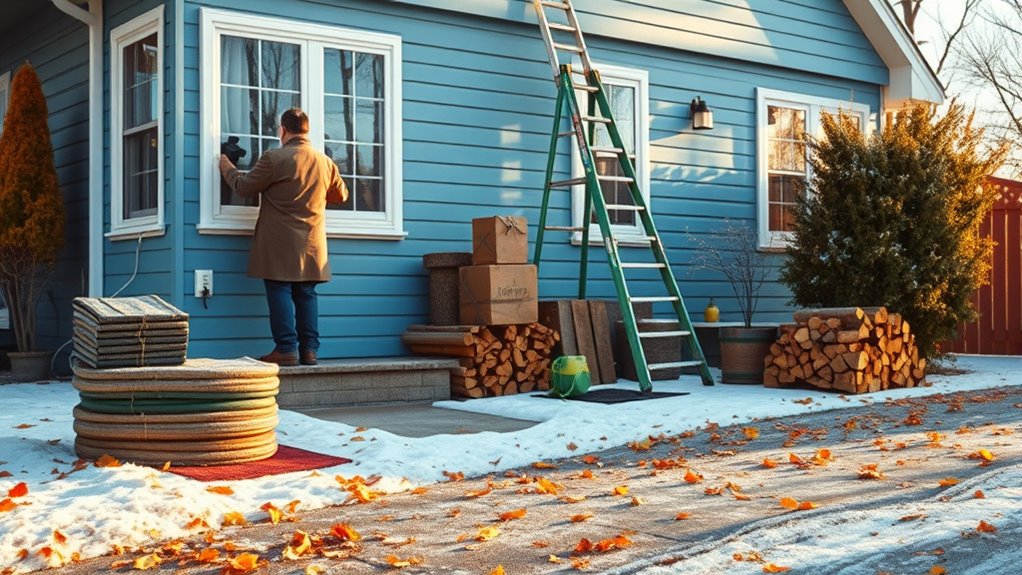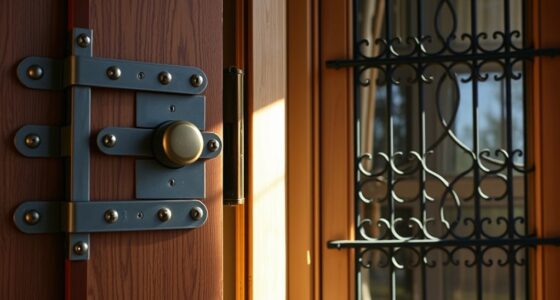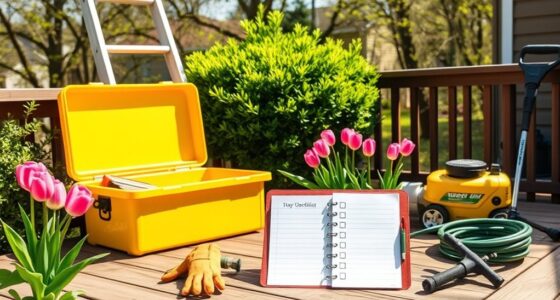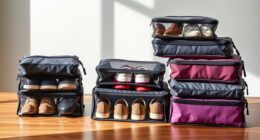To prepare your home for winter, start by insulating and sealing gaps around windows and doors to block drafts. Schedule a heating system inspection and change filters regularly to keep it running efficiently. Protect pipes by insulating exposed ones and draining outdoor faucets. Clear gutters and inspect the roof for damage to prevent leaks. Store outdoor furniture and secure decorations. These tips will help keep your home safe and cozy all season long. Keep going to discover more ways to winterize effectively.
Key Takeaways
- Schedule professional heating system inspections and replace filters regularly to ensure efficiency and prevent breakdowns.
- Seal gaps around doors and windows with weatherstripping or caulking to prevent heat loss and drafts.
- Insulate exposed pipes and drain outdoor faucets to prevent freezing and bursting.
- Clear gutters and secure downspouts to avoid ice dams and water damage.
- Cover outdoor furniture and store or protect outdoor appliances from snow and cold.
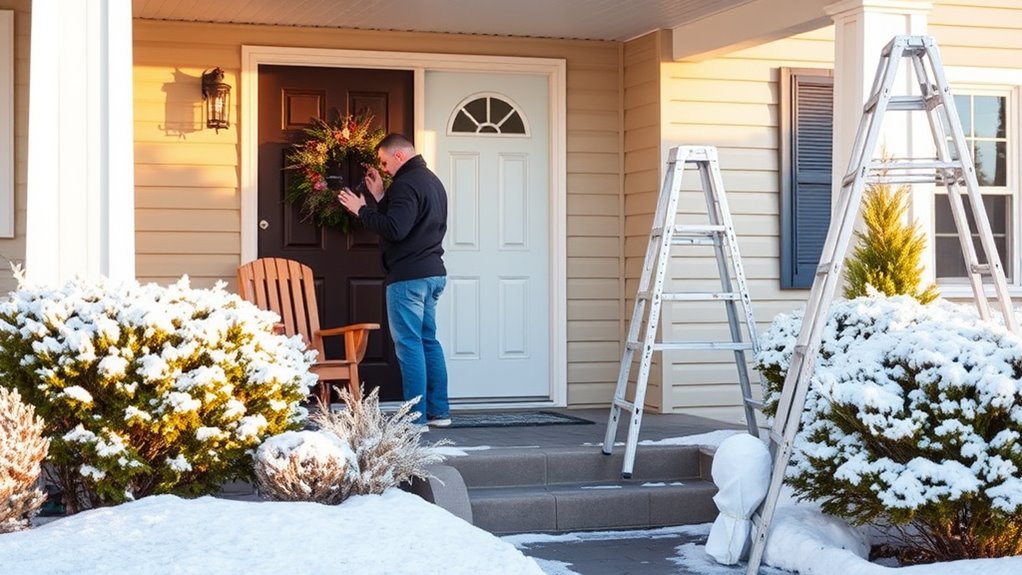
Preparing your home for winter is essential to avoid costly repairs, stay warm, and keep your family comfortable during the cold months. As winter approaches, preparing your home for the cold can save you money, prevent damage, and keep your family comfortable. Start by scheduling regular maintenance for your heating system. A professional inspection ensures your furnace or heat pump runs efficiently and helps prevent unexpected breakdowns on the coldest days. Don’t forget to replace your air filters every one to three months; dirty filters restrict airflow, strain your system, and reduce heating efficiency. While you’re at it, inspect your ductwork for leaks or gaps. Sealing these helps prevent warm air from escaping and improves overall home comfort. Check your thermostats to confirm they’re functioning correctly and consider upgrading to a programmable model. A programmable thermostat allows you to set different temperatures for day and night, optimizing energy use and reducing costs. Additionally, ventilation systems play a key role in maintaining indoor air quality and preventing moisture buildup during winter months.
Preparing your home for winter keeps your family warm, prevents costly repairs, and saves money on energy bills.
Insulation plays a crucial role in keeping heat inside. Examine your attic insulation, adding more if necessary, to prevent heat from escaping through the roof. Seal gaps and cracks around doors and windows with weatherstripping or caulking to block cold drafts. Insulate your walls if they’re not already, which helps maintain consistent indoor temperatures. Use draft stoppers on doors to block cold air from sneaking in underneath, and apply window insulation films or thermal curtains to reduce heat loss through your windows.
Protecting your plumbing is equally important. Insulate exposed pipes in unheated areas such as basements, garages, and outdoor spaces to prevent freezing. Drain outdoor faucets and disconnect garden hoses to avoid burst pipes. Consider installing foam pipe insulation for extra protection and schedule routine plumbing inspections to catch potential issues early. Disconnect and drain outdoor appliances like pool pumps or sprinkler systems to prevent damage during freezing temperatures.
Roof and gutter maintenance are critical for avoiding water damage. Inspect your roof for missing or damaged shingles and repair as needed. Clean your gutters thoroughly to prevent debris buildup, which can cause ice dams—leading to leaks inside your home. Secure downspouts to direct water away from your foundation and check your chimney for damage or obstructions to ensure safe fireplace use. Seal any roof leaks or gaps to prevent water infiltration.
Finally, prepare your electrical system and outdoor spaces. Check outlets for warmth or signs of electrical issues, and use surge protectors to shield electronics from power surges. Ensure circuit breakers aren’t overloaded. Install backup lighting like flashlights or batteries for emergencies. Store outdoor furniture and appliances, covering or draining them to protect against winter weather, and secure outdoor decorations to prevent damage from wind or snow. Taking these steps now will help you face winter confidently, knowing your home is ready for whatever the season brings.
Frequently Asked Questions
When Is the Best Time to Start Winterizing My Home?
The best time to start winterizing your home is early to mid-autumn, before temperatures drop too low. This gives you enough time to make repairs and complete preparations before winter storms arrive. Keep an eye on regional weather forecasts and act promptly if unexpected cold snaps or early snowstorms occur. Starting early guarantees your home stays protected, saving you money and stress during harsh winter weather.
How Do I Prevent Pipes From Freezing in Unheated Areas?
To prevent pipes from freezing in unheated areas, you should insulate them with foam sleeves or fiberglass and guarantee good airflow to avoid moisture buildup. Keep doors to these spaces open to promote warm air circulation. Install heat tape or cables to maintain consistent temperatures, and consider using thermostatic heat sources. Allow a trickle of water through the pipes during cold spells to prevent freezing, and seal any gaps or cracks around pipes.
What Are Eco-Friendly Options for Winterizing My Home?
Think of your home as a cozy nest, needing eco-friendly touches to stay warm naturally. You can choose sheep’s wool or cork insulation, both sustainable and effective. Installing smart thermostats helps optimize energy use, while planting evergreens or windbreaks reduces cold drafts. Sealing gaps with caulk or weatherstripping prevents heat loss. These choices honor nature’s balance while keeping your home warm, efficient, and environmentally friendly all winter long.
How Can I Maintain Indoor Air Quality During Winter?
To maintain indoor air quality during winter, you should use exhaust fans in kitchens and bathrooms regularly to reduce moisture and odors. Consider installing energy recovery ventilators (ERVs) to bring in fresh air while conserving heat. Use air purifiers with HEPA and activated carbon filters to trap pollutants and odors. Keep humidity levels balanced with humidifiers or dehumidifiers, and guarantee proper ventilation to prevent stale air buildup.
Are There Cost-Effective Methods to Winterize a Rental Property?
Looking for low-cost, clever ways to winterize your rental? Focus on sealing leaks by weatherstripping doors and windows to block drafts. Add affordable insulation like draft guards and curtains to conserve heat. Regularly maintain your heating system to prevent costly breakdowns. Plan for proactive pipe protection by draining and insulating outdoor pipes. These simple steps save money, maximize warmth, and make your property winter-ready without breaking the bank.
Conclusion
Now that you’ve got your home winterized, you’re like a cozy fortress ready to face the cold. With these simple steps, you’ll prevent costly damage and stay warm all season long. Remember, preparation is your best defense against winter’s chill—think of it as giving your home a warm sweater. Stay proactive, keep your systems in check, and enjoy a peaceful, worry-free winter knowing you’re well-prepared. Your home will thank you for it!

